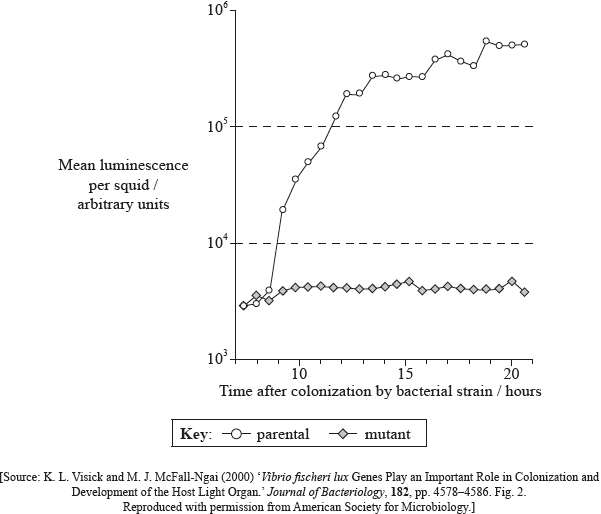| Date | November 2013 | Marks available | 2 | Reference code | 13N.3.SL.TZ0.16 |
| Level | Standard level | Paper | Paper 3 | Time zone | TZ0 |
| Command term | Evaluate | Question number | 16 | Adapted from | N/A |
Question
The bacterium Vibrio fischeri produces an enzyme called luciferase. This bacterium often colonizes the squid (Euprymna scolopes). A mutant strain of V. fischeri was obtained that was unable to produce luciferase. The graph shows the mean luminescence per squid after being colonized by the parental and mutant bacterial strains.

State the mean luminescence per squid 11.5 hours after colonization by parental V. fischeri.
Between 8.5 and 10.5 hours after colonization with the parental bacterial strain, luminescence increases by a factor of approximately 10. Estimate the factor by which luminescence increases between 8.5 and 17 hours after colonization with the parental bacterial strain.
Using the data in the graph, distinguish between luminescence in squid colonized by the parental and mutant bacterial strains.
Bioluminescence only happens when V. fischeri becomes part of a population with high density, for example when bacteria colonize the light organs of squid. Evaluate whether the data supports this hypothesis.
Markscheme
\({\text{1}}{{\text{0}}^{\text{5}}}\) (per squid)
100
low luminance in mutant strain while high luminance in parental strain (after 8 hours);
increase between 8 and 15 hours in parental strain but no increase in mutant strain;
only when more bacteria have grown (7 hours after colonization) luminescence can be seen;
luminescence has a rapid increase which could be caused by exponential growth of bacteria / population growth curve / example of quorum sensing;
there is no data for the number of bacteria colonizing the squid;
Examiners report
Many correctly read the graph for the 1 mark.
Only a few of the better candidates were able to estimate that 100 was the factor by which luminescence increased during the given time frame. The scale on the Y axis seemed to confuse candidates.
Few candidates were able to score more than 1 for noting that there was low luminescence in the mutant strain while high luminescence in the parental strain (after 8 hours).
Again, candidates struggled with this question and did not seem to understand the data sufficiently to evaluate the hypothesis given.

